Why Automated Business Communication is the Best Thing Since Email
- Andrew Leger
Why Automated Business Communication Is Changing Field Service Operations¶
Automated business communication uses technology to streamline communication between teams, partners, and customers without manual intervention. Here's what you need to know:
Key Components: - AI-powered chatbots for 24/7 customer support - Automated email sequences for follow-ups and confirmations - SMS notifications for appointment reminders and updates - Voice assistants for scheduling and basic inquiries - CRM integration for personalized messaging at scale
Main Benefits: - Save 30+ hours per week on routine communications - Reduce response times from hours to seconds - Cut communication costs by up to 30% - Improve customer satisfaction with instant responses - Scale operations without hiring additional staff
In today's business environment, customers expect instant responses. Research shows that 72% of companies are already using or experimenting with AI in major communication use cases, and businesses using AI chatbots are projected to save $11 billion annually by 2025.
For field service companies juggling scheduling, dispatch, and customer updates, manual communication creates bottlenecks that cost real money. Every missed call, delayed response, or forgotten follow-up is a potential lost customer.
Modern automation tools have evolved far beyond simple auto-responders. Today's systems use artificial intelligence to understand context, personalize messages, and even detect customer emotions to adjust responses accordingly.
I'm Andrew Leger, and I've spent over 15 years building enterprise-grade systems that automate workflows across healthcare, staffing, and logistics industries. Through developing ServiceBuilder, I've seen how automated business communication transforms field service operations by eliminating manual tasks and improving customer relationships.
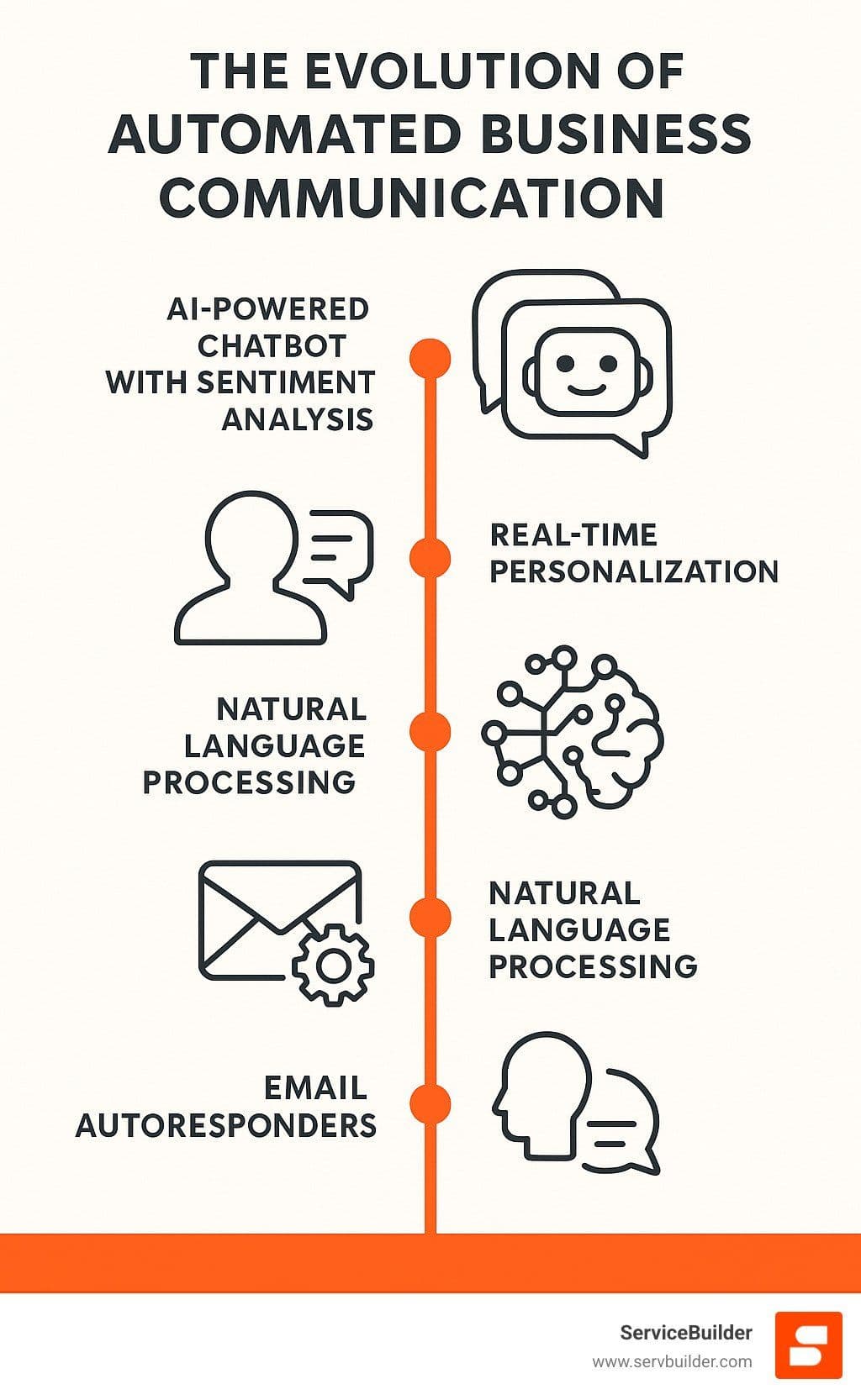
Quick automated business communication definitions: - automated accounts receivable system - automated bookkeeping services
The Evolution From Email to Automated Business Communication¶
Email fatigue is real, and it's costing businesses money. The average employee now receives hundreds of messages daily, and manual responses can't compete with customer expectations for instant acknowledgment.
The shift toward automated business communication addresses three critical pain points:
1. Speed Requirements Have Changed Responding to leads within five minutes is critical for engagement. When a potential customer fills out a contact form at 9 PM, they shouldn't wait until the next business day for confirmation.
2. Scale Demands Are Overwhelming Small field service businesses often handle hundreds of customer interactions weekly. Manual communication becomes a full-time job. The projected $11 billion in annual savings from chatbots by 2025 demonstrates the massive efficiency gains possible.
3. Personalization at Scale Was Impossible Modern automation uses AI to deliver personalized marketing that can increase revenue by up to 40%, with 71% of customers now expecting this level of engagement.
Speed & Efficiency Gains¶
The change from manual to automated communication delivers measurable efficiency gains:
Instant Response Capabilities - Chatbots provide immediate acknowledgment of customer inquiries - Automated appointment confirmations eliminate back-and-forth scheduling calls - Self-service portals let customers reschedule without human intervention - IVR systems deflect routine calls to appropriate departments
Error Reduction Manual communication introduces human error - typos in appointment times, forgotten follow-ups, or inconsistent messaging. Automation eliminates these mistakes while ensuring every customer receives the same professional experience. This is particularly crucial for field service businesses where scheduling errors can cascade into costly dispatch mistakes. For more insights on avoiding these pitfalls, check out our guide on FSM Scheduling & Dispatch Mistakes.
24/7 Availability Automated systems work around the clock. Late-night emergency calls get immediate acknowledgment, weekend inquiries receive instant responses, and holiday scheduling requests are processed automatically.
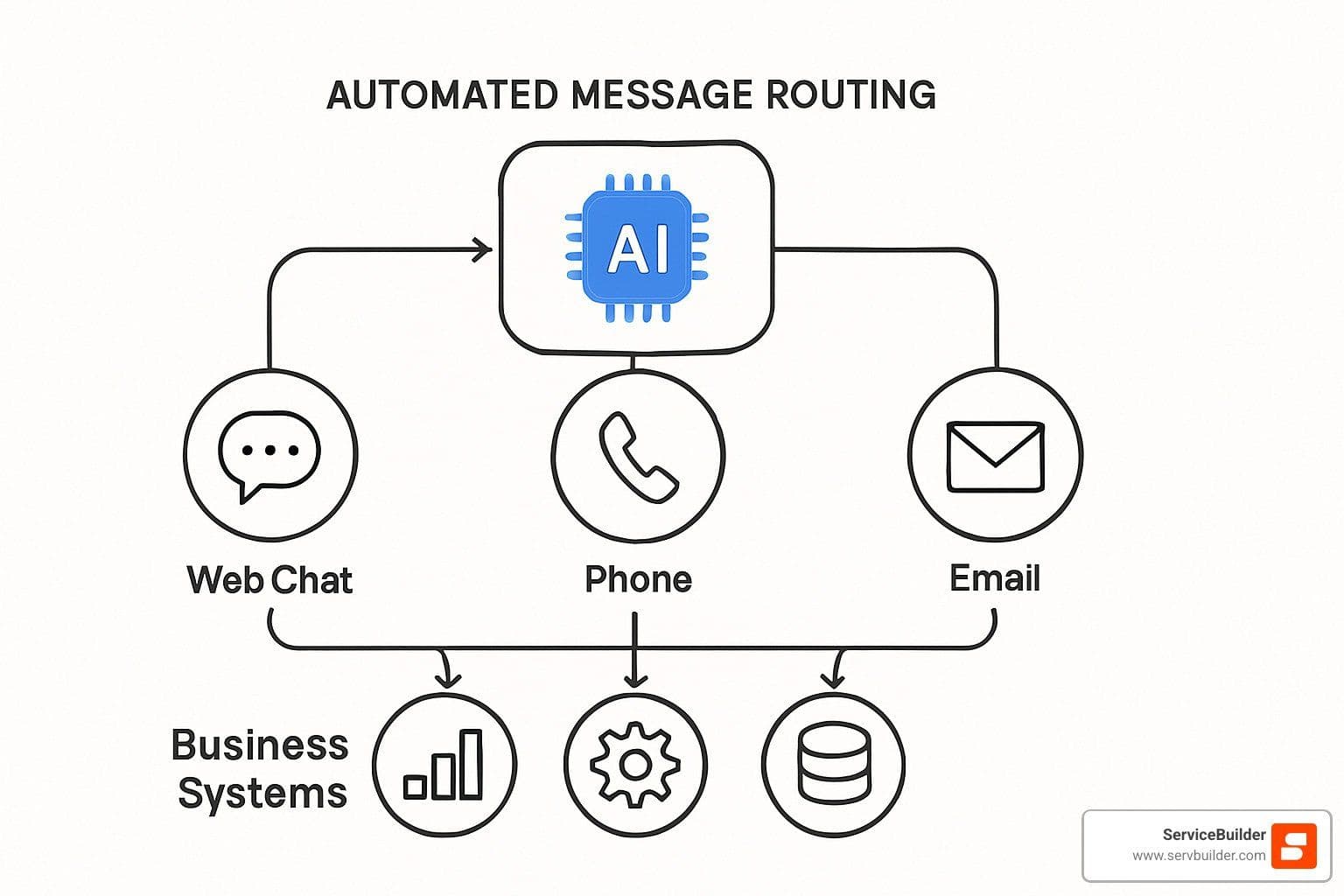
How Automated Business Communication Personalizes Customer Journeys¶
Modern automation creates genuinely personalized experiences:
Behavior-Triggered Communications - Send follow-up emails when customers abandon quote requests - Trigger service reminders based on equipment maintenance schedules - Deliver targeted promotions based on past service history - Automatically escalate communications when sentiment analysis detects frustration
AI-Powered CRM Integration Smart systems pull customer data to personalize every interaction. Instead of "Dear Customer," messages reference specific services, previous technicians, or upcoming maintenance needs.
Predictive Engagement Machine learning identifies patterns in customer behavior to predict needs. For example, if HVAC customers typically schedule maintenance every six months, the system automatically sends reminders at the optimal time.
According to research on customer personalization, companies that excel at personalization generate 40% more revenue from those activities than average players.
The Tech Stack Behind Automation Magic¶
Modern communication automation relies on key technologies working together. Natural Language Processing (NLP) helps computers understand what people are actually saying. When a customer texts "my AC is acting weird," NLP figures out they probably need HVAC service.
Machine learning makes systems smarter over time by learning from every interaction. Speech analytics processes voice calls to extract insights and automatically trigger follow-up actions. Predictive routing directs communications to the team member most likely to solve the problem quickly.
ServiceBuilder's privacy-first architecture protects customer data through encryption and role-based access controls while enabling powerful automation features.
For technical details, IBM's research on natural language processing breaks down how NLP actually works.
Core Components: Bots, Triggers & Integrations¶
Modern chatbots can hold natural conversations, process service requests, create work orders, schedule appointments by checking real-time availability, and collect customer information to update your CRM automatically. Smart bots know when to bring in a human for complex issues.
Webhook triggers work like an attentive assistant. New customer inquiry? Welcome sequence starts automatically. Service completed? Review request goes out. Invoice overdue? Payment reminder series kicks in.
Omnichannel integration consolidates all touchpoints into a unified inbox where every interaction builds on the last. Sentiment dashboards give real-time pulse on customer feelings, automatically escalating frustrated customers to your best service people.
Choosing the Right Engines & APIs¶
Open-source solutions offer customization but require technical expertise. Commercial platforms provide easier implementation with ongoing support. Hybrid approaches combine commercial reliability with custom integrations - where ServiceBuilder excels.
Security features like role-based access controls ensure appropriate data access, while regular bias audits prevent AI systems from developing unfair patterns. Tools like AI Fairness 360 help identify and correct algorithmic bias before it affects customers.
Use Cases & Platform Showdown for Automated Business Communication¶
Automated business communication transforms field service operations in three core areas:
Customer support eliminates phone tag and business-hour limitations with instant acknowledgment and 24/7 availability.
Marketing automation replaces generic messaging with targeted communications - maintenance reminders for customers who need them and seasonal offers for ready prospects.
Internal operations streamline when teams stop drowning in administrative tasks through automated meeting notes, project updates, and seamless information sharing.
ServiceBuilder integrates these capabilities into a platform built specifically for technicians and dispatchers who need real-time updates without complexity.
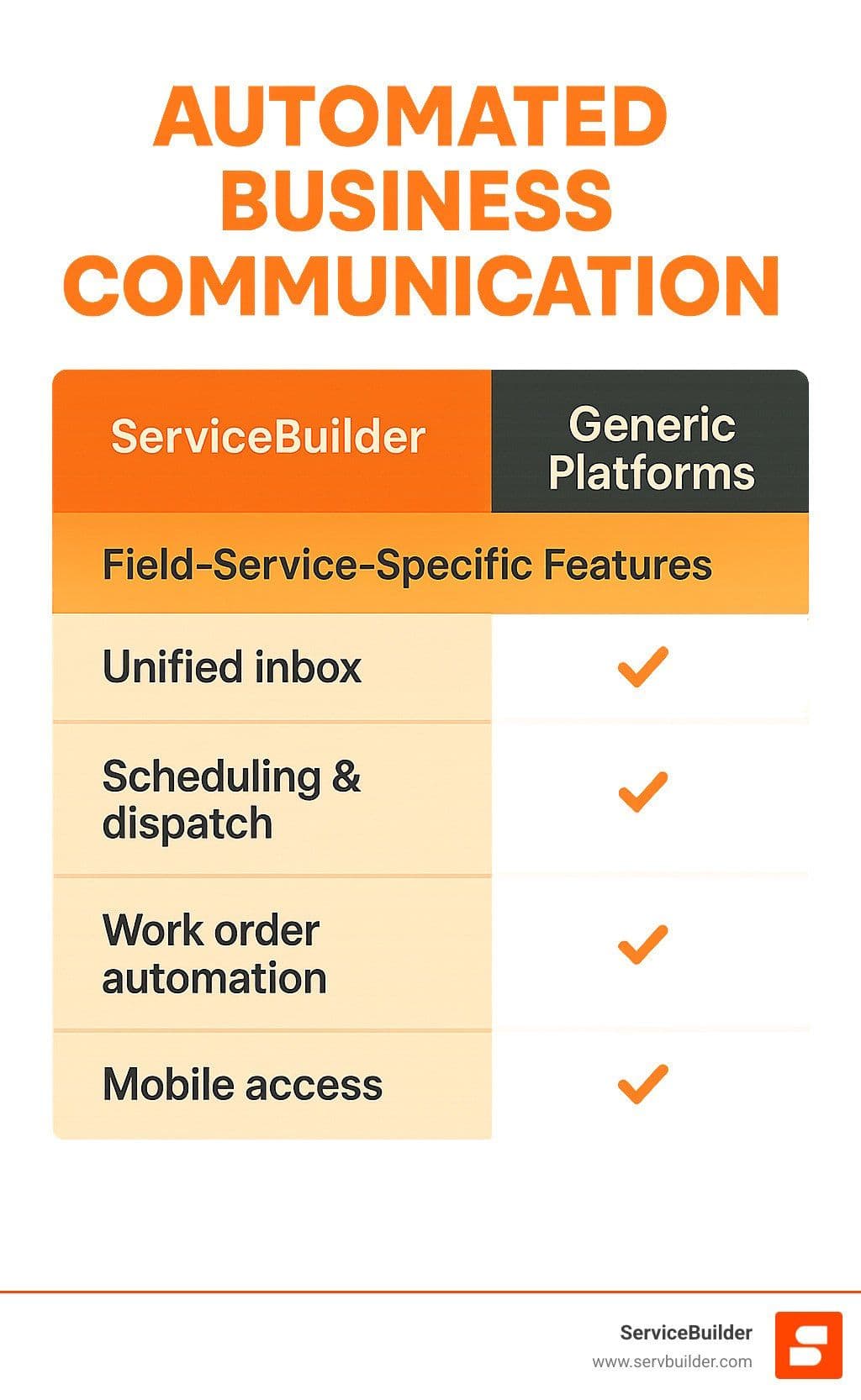
Customer Support Automation & Human Escalation¶
Smart automated business communication improves human judgment rather than replacing it.
Intelligent triage works like a skilled receptionist. Emergency service requests trigger immediate alerts to on-call technicians with customer location and service history. Routine questions get answered instantly by chatbots. Complex technical issues route directly to specialized support agents with full context.
Emotion detection analyzes tone and language in customer messages. When AI detects frustration or urgency, it immediately escalates to human agents or offers additional compensation to preserve relationships.
CSAT monitoring happens automatically after every interaction with brief feedback requests immediately after service completion, helping identify problems before they escalate.
Marketing & Sales Drip Sequences on Autopilot¶
Welcome sequences for new customers set proper expectations from day one with carefully crafted series introducing your team, explaining processes, and providing maintenance tips.
Nurture campaigns keep you top-of-mind with prospects who aren't ready to buy immediately through valuable information and expertise showcasing.
Reactivation campaigns generate revenue from existing relationships by reaching out to customers who haven't used services recently with seasonal maintenance reminders and targeted promotions.
The key is relevance - field-service-specific automation understands that lawn care customers need different messaging than HVAC customers.
Internal Ops: Meetings, Projects & Knowledge Sharing¶
Automated documentation eliminates administrative burden through meeting recordings that generate searchable transcripts, automatic project updates, and knowledge bases that capture solutions for technicians.
Real-time translation ensures everyone stays informed regardless of language barriers for both internal team communication and customer interactions.
ServiceBuilder's integrations streamline these processes while maintaining the mobile-first experience that field service teams need, allowing technicians to access customer history, update job status, and communicate with dispatch without switching apps.
Implementation Roadmap & ROI Tracking¶
Implementing automated business communication doesn't need to be overwhelming. The most successful implementations start small and build momentum.
Start with a communication audit. Track how much time your team spends on repetitive messages - appointment confirmations, follow-up calls, scheduling coordination. One HVAC company found they were spending 15 hours weekly just on appointment confirmations.
Define success metrics upfront. What does winning look like? Faster response times? Fewer missed appointments? Having clear KPIs prevents distraction by features that don't move the needle.
Choose your pilot project carefully. Start with appointment reminders or basic FAQ responses - high impact but low risk. These happen frequently enough to show quick results without breaking your business if something goes wrong.
Your integration plan needs to work with existing systems rather than replacing everything at once. Most field service businesses already have scheduling software, CRM systems, and communication tools in place.
Change management is where most implementations fail. Be transparent about how automation eliminates boring, repetitive tasks so teams can focus on solving complex customer problems and building relationships.
For guidance on separating genuine automation value from marketing hype, check out our guide on AI in Field Service: Real vs Buzzwords.
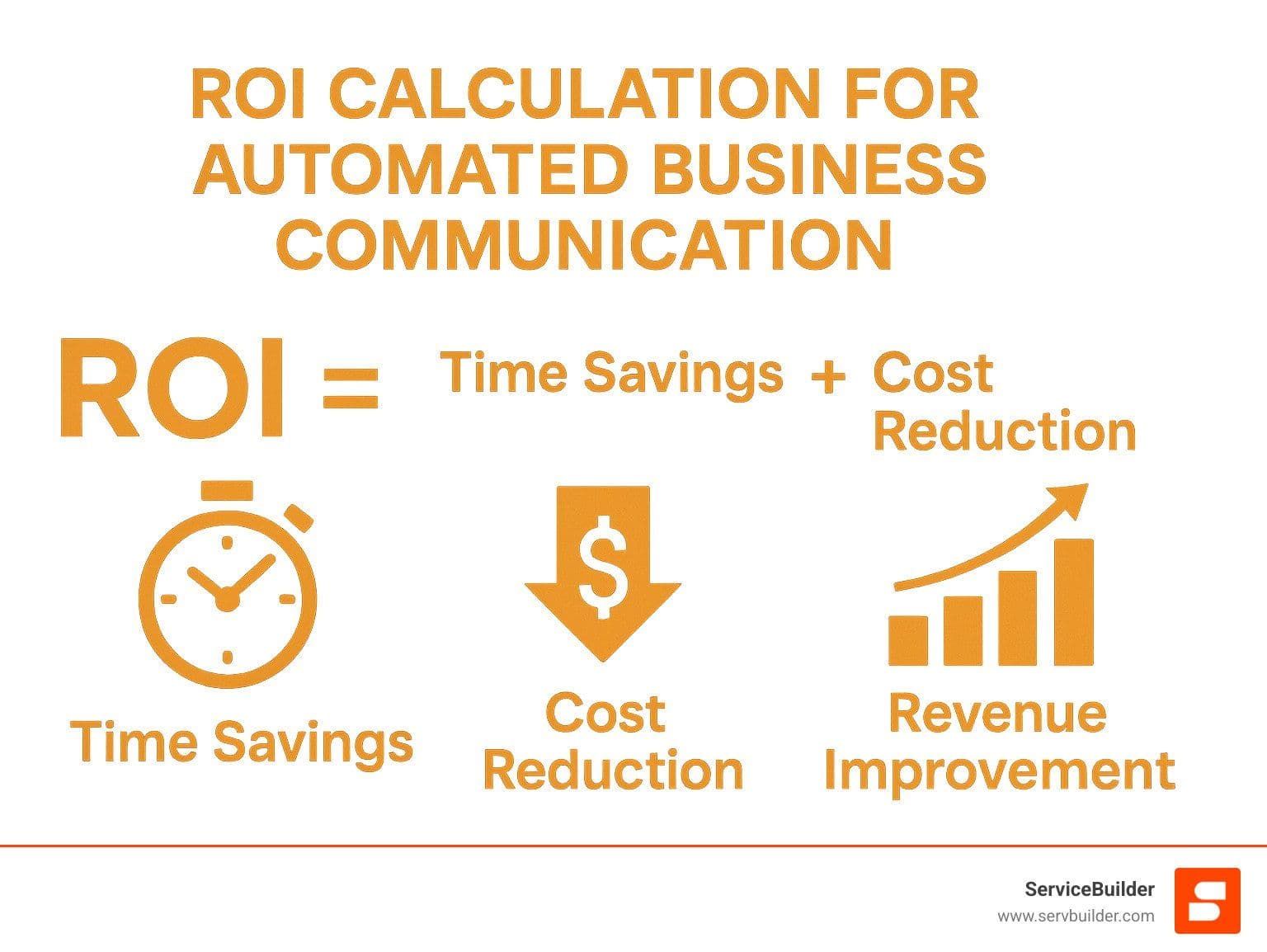
Measuring ROI of Automated Business Communication¶
Response time improvements are usually the first win. Track average response time before and after - the difference will be dramatic.
Cost per conversation tells the real story. Add up all communication costs and divide by total customer interactions. Automation typically cuts this by 30% or more.
Revenue impact matters too. Automated follow-ups catch opportunities that slip through cracks. One pest control company increased annual maintenance renewals by 25% through automated renewal reminders.
Employee satisfaction improves when teams stop spending hours on repetitive tasks, leading to higher productivity and retention.
From Pilot to Scale Without Breaking Things¶
Start with internal communications first. Test automation on meeting summaries or project updates before exposing customers to potential glitches.
Phased rollouts prevent disasters. Begin with appointment confirmations for new customers only. Once running smoothly, expand to existing customers, then add service reminders, then billing notifications.
Create feedback loops through weekly team check-ins, monthly customer satisfaction surveys, and quarterly performance reviews. The goal is continuous improvement, not perfection.
ServiceBuilder focuses on gradual implementation that respects how field service businesses operate, adding automation capabilities as teams get more experienced.
Mitigating Risks: Security, Privacy & Compliance¶
Automation can feel scary when dealing with customer data and business-critical communications. Most security concerns have straightforward solutions with proper planning.
Data protection starts with basics. Every customer conversation, payment detail, and service history needs encryption both in transit and storage. Role-based access controls ensure appropriate data access - office managers can't see financial data meant for accounting, while technicians only access needed job information.
SOC-2 compliance, GDPR requirements, and CCPA regulations provide roadmaps for protecting your business and customers. Small field service businesses are increasingly targeted because hackers assume weaker defenses.
AI bias prevention requires ongoing attention. Automated systems learn from data, and biased data creates biased automation. Regular audits of automated responses, diverse training data, and human oversight prevent unfair patterns.
Business continuity planning prevents disasters. Having backup systems, manual override capabilities, and clear escalation procedures keeps your business running when technology fails - particularly crucial for field service where communication breakdowns can strand technicians.
For comprehensive guidance on selecting secure systems, our guide on how to choose FSM software in 2025 covers essential security considerations.
Keeping Customer Trust Intact with Automated Business Communication¶
Trust is everything in field service. Automated business communication should strengthen rather than undermine customer relationships.
Transparency builds confidence. Clear disclosure at interaction beginnings sets appropriate expectations. "I'm ServiceBot and I'm here to help with scheduling and basic questions" works better than pretending to be human.
Opt-in controls put customers in charge. Explicit consent for automated communications is legally required and good business practice. Easy unsubscribe options and frequency controls let customers customize preferences without abandoning your service.
Human override options provide essential safety nets. Every automated system needs clear escape routes - live chat escalation, dedicated phone numbers for urgent issues, and email addresses for complex problems ensure customers never feel trapped.
Integration Nightmares & How to Avoid Them¶
Legacy system challenges require creative solutions. API gateways act as translators between old and new systems. Middleware platforms handle data synchronization. Gradual migration strategies maintain business continuity while modernizing.
Version control prevents configuration chaos. Detailed records of integration configurations help troubleshoot problems. Testing updates in staging environments catches issues before customers see them.
Vendor SLA requirements protect your business through clear service level agreements specifying response times, uptime guarantees, and escalation procedures when things go wrong.
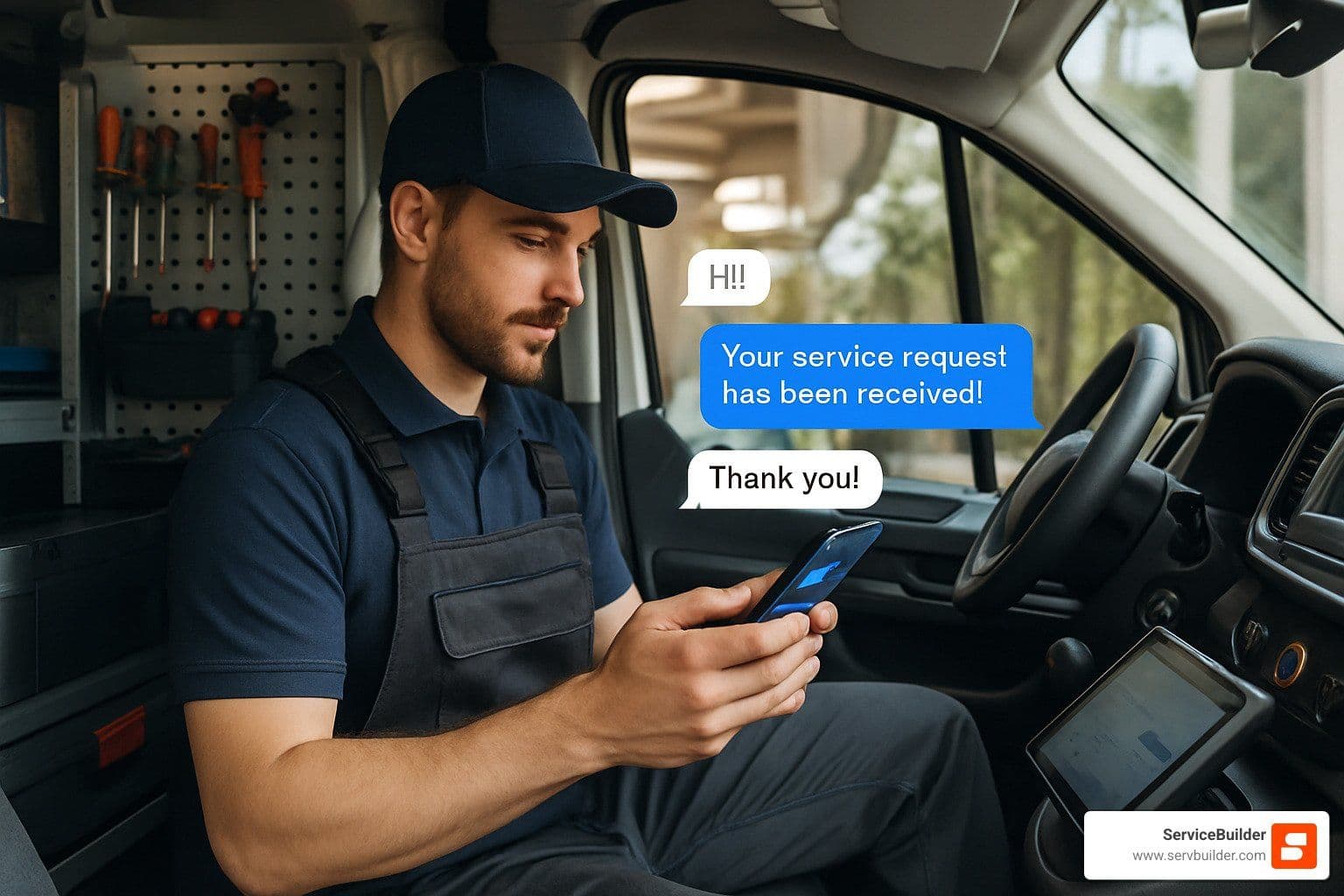
Frequently Asked Questions about Automated Business Communication¶
What technologies make automation possible?¶
Natural Language Processing (NLP) helps computers understand what customers actually mean. When someone texts "My AC is acting weird," NLP knows they need HVAC support.
Machine Learning systems get better at their job every day, learning from every customer interaction and gradually improving responses.
APIs are invisible connectors that make everything work together seamlessly, letting your scheduling software talk to your texting system and billing platform automatically.
Cloud computing provides 24/7 reliability, while mobile optimization ensures automation works equally well on phones and computers.
How much time and money can SMBs really save?¶
Most field service companies save 30+ hours per week once they implement automated communication - nearly a full-time employee's worth of work without salary and benefits.
Communication costs typically drop by 30% when you automate routine interactions instead of paying for phone time and staff hours on repetitive tasks.
Personalized automated marketing can boost revenue by up to 40% by reaching customers at exactly the right moment with the right message. 88% of teams using AI tools report weekly time savings, meaning technicians spend more time fixing problems and less time on paperwork.
Will automation replace my customer-facing staff?¶
Automated business communication makes your team more valuable, not less necessary. Automation handles boring, repetitive work so people can do interesting, high-value tasks.
Routine inquiries like business hours and appointment confirmations work great with automation. Basic troubleshooting questions get instant responses even at midnight.
But complex technical problems requiring years of experience, emotional situations needing genuine empathy, and sales conversations building trust and rapport still need the human touch.
The goal is freeing your team from mundane tasks so they can focus on work requiring human judgment, expertise, and relationship-building skills.
Conclusion¶
The shift to automated business communication is fundamentally changing how successful field service businesses operate. With 72% of companies already experimenting with AI communications and the industry heading toward $11 billion in annual savings by 2025, this isn't just another tech trend.
Think about your typical Tuesday morning - juggling appointment confirmations, rescheduling requests, follow-up calls, and new customer inquiries before your first technician hits the road. Automated business communication eliminates this chaos by handling routine interactions instantly, letting you focus on growing your business.
For field service companies, automation eliminates scheduling conflicts, provides instant responses when competitors check voicemail, and reduces administrative overhead that keeps small businesses from scaling. Your customers get professional, consistent communication whether they contact you at 2 PM or 2 AM.
ServiceBuilder approaches this differently than generic platforms. We built our system specifically for U.S. field service teams who need mobile-first experiences and AI-assisted scheduling that understands their workflow. Our privacy-first architecture protects customer data while delivering real-time updates and intuitive design for busy operators.
Unlike bloated enterprise systems, ServiceBuilder gets the unique challenges of HVAC, lawn care, cleaning, and pest control businesses. Our automation features integrate seamlessly with scheduling, dispatch, and team communication workflows you actually use - not features designed for Fortune 500 companies.
The field service industry is becoming more competitive every year. Customers expect faster responses, professional communication, and seamless scheduling experiences. Automated business communication isn't just nice-to-have anymore - it's essential for staying competitive.
Ready to see how automation can transform your operations? Contact us today and we'll show you exactly how ServiceBuilder's communication features work for your specific field service business. Our team understands your unique challenges because we built our platform specifically for businesses like yours.
The future belongs to field service companies that accept automation while maintaining the personal touch that builds lasting customer relationships. The question isn't whether you'll eventually adopt these technologies - it's whether you'll implement them before your competition does.